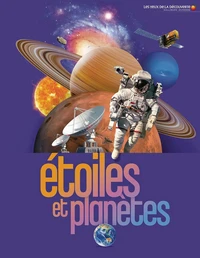Astronomy in Minutes. 200 Key Concepts Explained in an Instant
Par :Formats :
Disponible dans votre compte client Decitre ou Furet du Nord dès validation de votre commande. Le format ePub protégé est :
- Compatible avec une lecture sur My Vivlio (smartphone, tablette, ordinateur)
- Compatible avec une lecture sur liseuses Vivlio
- Pour les liseuses autres que Vivlio, vous devez utiliser le logiciel Adobe Digital Edition. Non compatible avec la lecture sur les liseuses Kindle, Remarkable et Sony
- Non compatible avec un achat hors France métropolitaine
 , qui est-ce ?
, qui est-ce ?Notre partenaire de plateforme de lecture numérique où vous retrouverez l'ensemble de vos ebooks gratuitement
Pour en savoir plus sur nos ebooks, consultez notre aide en ligne ici
- Nombre de pages416
- FormatePub
- ISBN978-1-84866-724-2
- EAN9781848667242
- Date de parution18/03/2015
- Protection num.Adobe DRM
- Infos supplémentairesepub
- ÉditeurGreenfinch
Résumé
What happens when a star dies? How many asteroids are in our solar system? Can galaxies collide? What is dark energy? Astronomy in Minutes answers all these questions and more as it condenses 200 key concepts into easily digestible essays. From Trojan asteroids to stellar black holes, and from superclusters to cosmic microwave background, this book will take you on an essential tour around the universe.
Beginning with the specks and constellations that we see in the night sky, and then zooming in on the objects and 'matter' beyond the naked eye, Astronomy in Minutes draws on established theories and recent research. Each essay is accompanied by an image or a clear diagram to help unravel complex ideas. Beginning with the constellations and finishing with the latest cosmological theories, this is the perfect reference guide to this fascinating subject.
Contents include: The celestial sphere, Piscis Austrinus, the Earth-Moon system, Io and Ganymede, Kuiper Belt Objects, Measuring stellar properties, Nuclear fusion, Red and orange dwarfs, Open star clusters, Planetary nebulae, Supernova remnants, Cosmic expansion, Quasars and blazars, Nature of spacetime, Nucleosynthesis and the Anthropic Principle.
Beginning with the specks and constellations that we see in the night sky, and then zooming in on the objects and 'matter' beyond the naked eye, Astronomy in Minutes draws on established theories and recent research. Each essay is accompanied by an image or a clear diagram to help unravel complex ideas. Beginning with the constellations and finishing with the latest cosmological theories, this is the perfect reference guide to this fascinating subject.
Contents include: The celestial sphere, Piscis Austrinus, the Earth-Moon system, Io and Ganymede, Kuiper Belt Objects, Measuring stellar properties, Nuclear fusion, Red and orange dwarfs, Open star clusters, Planetary nebulae, Supernova remnants, Cosmic expansion, Quasars and blazars, Nature of spacetime, Nucleosynthesis and the Anthropic Principle.
What happens when a star dies? How many asteroids are in our solar system? Can galaxies collide? What is dark energy? Astronomy in Minutes answers all these questions and more as it condenses 200 key concepts into easily digestible essays. From Trojan asteroids to stellar black holes, and from superclusters to cosmic microwave background, this book will take you on an essential tour around the universe.
Beginning with the specks and constellations that we see in the night sky, and then zooming in on the objects and 'matter' beyond the naked eye, Astronomy in Minutes draws on established theories and recent research. Each essay is accompanied by an image or a clear diagram to help unravel complex ideas. Beginning with the constellations and finishing with the latest cosmological theories, this is the perfect reference guide to this fascinating subject.
Contents include: The celestial sphere, Piscis Austrinus, the Earth-Moon system, Io and Ganymede, Kuiper Belt Objects, Measuring stellar properties, Nuclear fusion, Red and orange dwarfs, Open star clusters, Planetary nebulae, Supernova remnants, Cosmic expansion, Quasars and blazars, Nature of spacetime, Nucleosynthesis and the Anthropic Principle.
Beginning with the specks and constellations that we see in the night sky, and then zooming in on the objects and 'matter' beyond the naked eye, Astronomy in Minutes draws on established theories and recent research. Each essay is accompanied by an image or a clear diagram to help unravel complex ideas. Beginning with the constellations and finishing with the latest cosmological theories, this is the perfect reference guide to this fascinating subject.
Contents include: The celestial sphere, Piscis Austrinus, the Earth-Moon system, Io and Ganymede, Kuiper Belt Objects, Measuring stellar properties, Nuclear fusion, Red and orange dwarfs, Open star clusters, Planetary nebulae, Supernova remnants, Cosmic expansion, Quasars and blazars, Nature of spacetime, Nucleosynthesis and the Anthropic Principle.





















